Autumn is my favorite season by far, as I’m constitutionally drawn to change, whether it’s the start of a new school year, the stultifying heat of summer breaking, or the rotation of a stale Magic format. It’s a refreshing time, particularly if you live somewhere where it’s been hovering around ninety degrees for two months or if you’ve been playing Cragcrown Pathway for two years.
This is a particularly welcome revitalization, too—the time dilation of the pandemic era means that some of the sets that rotate out of Standard on Friday have gotten familiar enough to seem stale, especially when you used Arena as a pandemic distraction tool and ground an absurd number of Zendikar Rising drafts.
We’re losing some powerful cards this rotation, without a lot to directly replace them. This can lead to creativity, as in the loss of Goldspan Dragon, which was simply the best thing Red could do at five mana. I’ll miss Snow-Covered lands, and the premier removal spell Blizzard Brawl that they enabled. And I will especially miss Binding the Old Gods, which was the glue for every base-Golgari decks I’ve played over the last eighteen months.
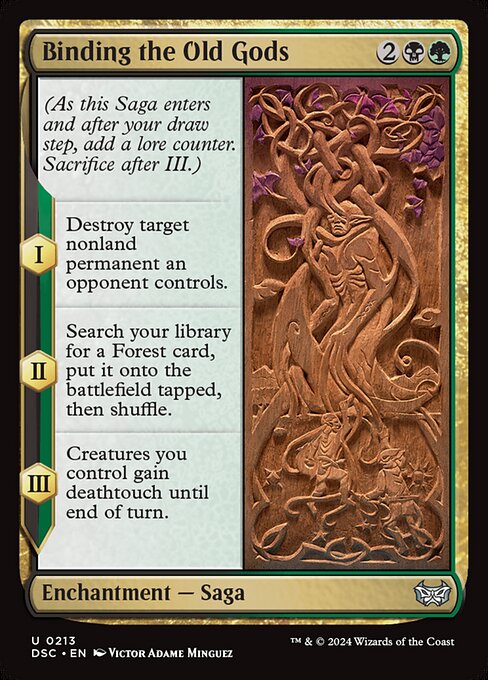
Also gone are a whole host of cards that never quite got there, from Zendikar’s +1/+1 counters deck to Kaldheim’s Giants to 98% of Strixhaven cards. Gone, too, are cards that enabled entire archetypes: Ruin Crab, Magda, Brazen Outlaw, Sedgemoor Witch, Righteous Valkyrie, Ranger Class, etc.
Into that breach comes Dominaria United, which is a bit lower on the power scale than some sets rotating out of Standard. That’s not quite a critique, as the set is a delight to draft. I’ve been joyfully squeaking out games with Sultai Walls and testing out the surprisingly powerful Domain deck. The new set is full of interesting cards—they’re just more suggestive of new archetypes than of objective power.
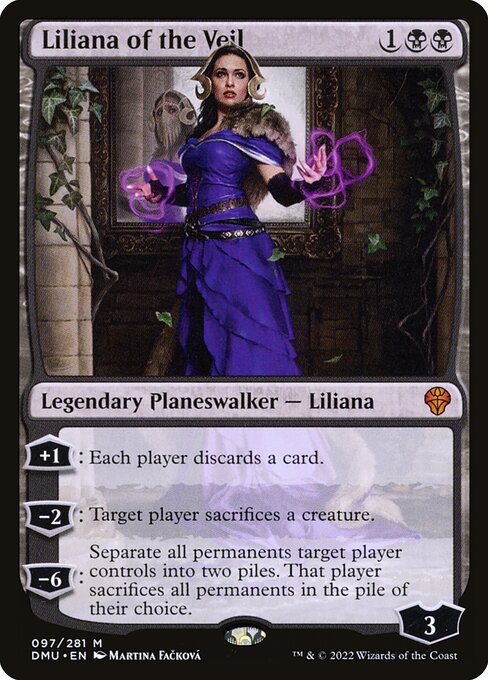
The most exciting cards in Dominaria United are reprints: Pioneer now has 60% of the painlands (with the rest projected to follow in a couple of months) and Liliana of the Veil returns to Standard for the first time in a decade and makes her debuts in Pioneer. With Ob Nixilis, the Adversary in the format, the three-drop discard Planeswalker spot is looking great, and Rakdos stands poised to dominate in Standard and Pioneer/Explorer.
Goodbye To All That
Before we get sick of the Rakdos mirror match, I thought we should take some time to see the old Standard off and welcome in the new. Eevery season is a time of change, but the tinge of melancholy, of darker days ahead, inherent to autumn makes me nostalgic. A fond farewell to:
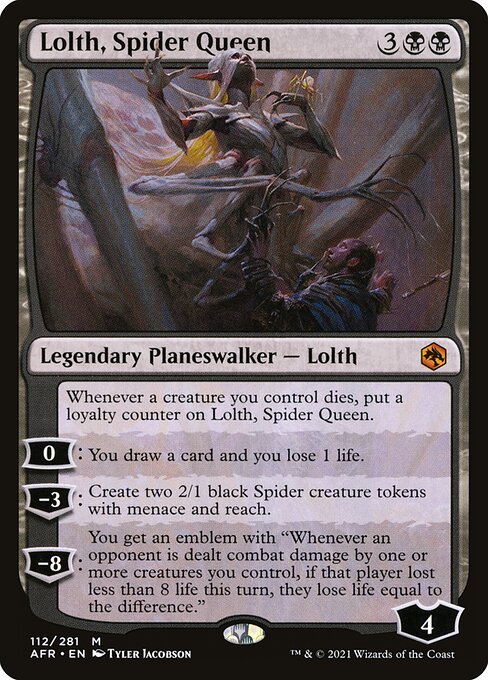
Lolth and her minions: base-Black sacrifice decks have passed in and out of favor; but the most recent iteration, with Shambling Ghast, Eyetwitch, and Lolth, Spider Queen, backed up by Blood on the Snow and Deadly Dispute, was a prime build. It ran some notably underpowered cards, yet the engine they created together was a dependable and adaptable deck that squared up well against the pillars of Standard. Never dominant and never a bad choice, it’ll be missed—especially as it and Liliana never got the chance to coexist in Standard.
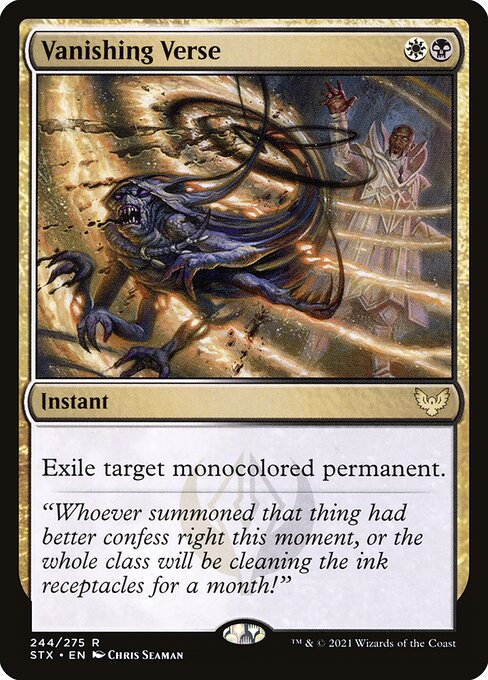
Two catch-all removal spells, Skyclave Apparition and Vanishing Verse, were maindeckable answers to almost every deck in the format with only minor drawbacks. We still have Brutal Cathar and Leyline Binding, both of which are poised to becomes staples in the new Standard, but the simplicity of Vanishing Verse and the flexibility and tension of Apparition will be missed.
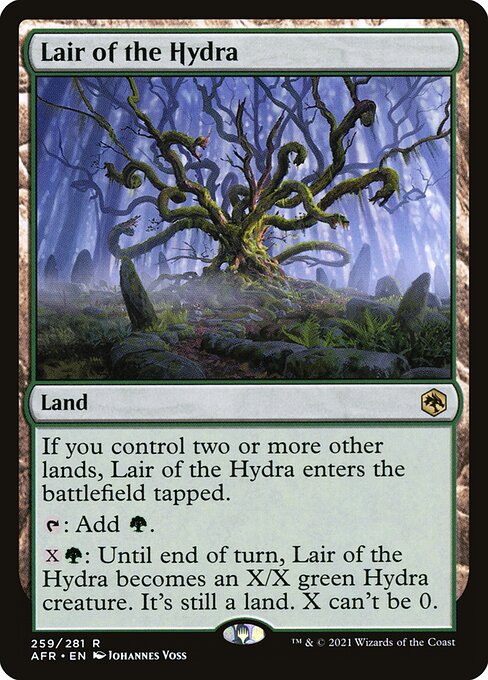
The Adventures Creature Lands: Cave of the Frost Dragon, Hall of Storm Giants, Hive of the Eye Tyrant, Den of the Bugbear, and Lair of the Hydra all hit the sweet spot of powerful but balanced. I can’t recall the last time I built a mono- or dual-colored deck that didn’t include a copy or two of the relevant lands—they’re great threats that scale well, from the evasive Cave and Hive to the flexible Lair and Goblin-enabling Den.
Hall was sometimes interchangeable with any non-interactive control threat, but in general, these lands belong in the pantheon of well-balanced cycles. I expect them to continue popping up in Pioneer and Historic, but not at the rate they defined Standard, so let’s offer a fond send-off to the squad.
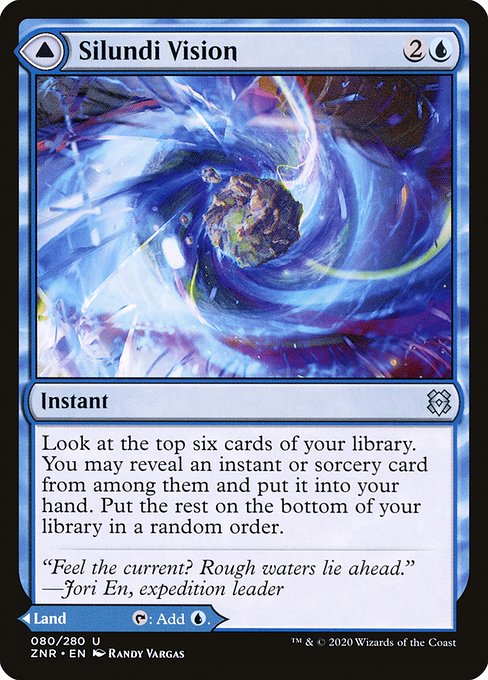
The Zendikar Rising modal Double-Faced Cards: The Pathways were crucial to a healthy standard and have served well as painland-placeholders in Pioneer, but it was the dual-mode spell/lands that will be the reason the set is remembered. They trained Commander players to run a healthier land mix in their decks, temporarily created broken decks in Pioneer before the banning of Balustrade Spy, and smoothed out Limited by ensuring you almost always could interact with your opponent or trigger Landfall.
While the Mythic cycle are the most memorable, I’ll miss the security of knowing my cards can either be reasonable curve-fillers or lands in a pinch—cards like Khalni Ambush, Blackbloom Rogue, and Sejiri Shelter may be situational, but they do the most valuable thing a Magic card can do: allow the player more opportunity to actually play the game.
These will all be missed, but rotation isn’t just loss: there’s also the chance for previously-underplayed cards to find their niche from sets overshadowed by the rotating cards, as well as brand-new opportunities for the oncoming set.
Welcome Back to Dominaria
Dominaria United may not have the splash of Neon Dynasty or the immediately-apparent staples of Midnight Hunt, but since we’ll be playing with it through 2024, it’s the set that will reward the most study and familiarity. I’ve been familiarizing myself on Arena—where, yes, I won my first game with Argivian Cavalier. I have been impressed by several cards that can make the jump from 40-card to 60-card decks, some of which are obvious and some less so. Further study can come, but for now, these are the cards about which I’m most excited from Dominaria United:
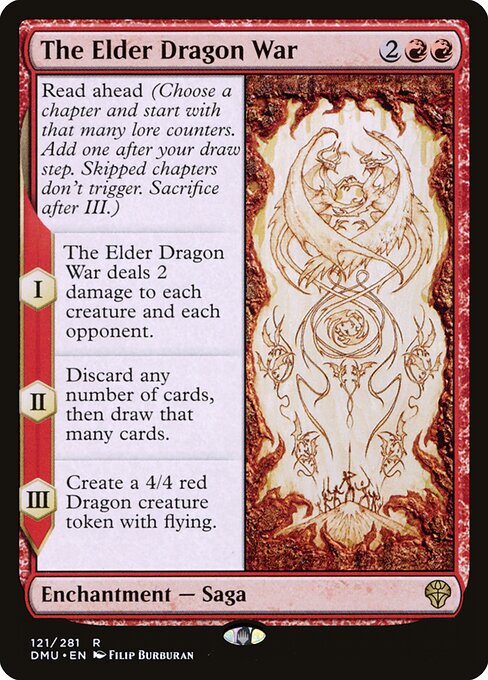
I find Sagas to be so elegant that any changes feel like they’re adulterating perfection, but adding a modular component via Read Ahead is pretty brilliant. Of the Read Ahead Sagas, The Elder Dragon War is the most exciting: it’s a modal Pyroclasm, a third of a Fable of the Mirror-Breaker, or a cheap 4/4 flier, or all three if you’re willing to wait.
Obviously a Limited bomb, but I have hopes for this in Standard—it’s been a while since Pyroclasm was relevant, and never at four mana, but the ability to churn through cards and/or create Verix Bladewing depending on need is the exact sort of option that makes uninspiring cards on the page become Standard staples once played.
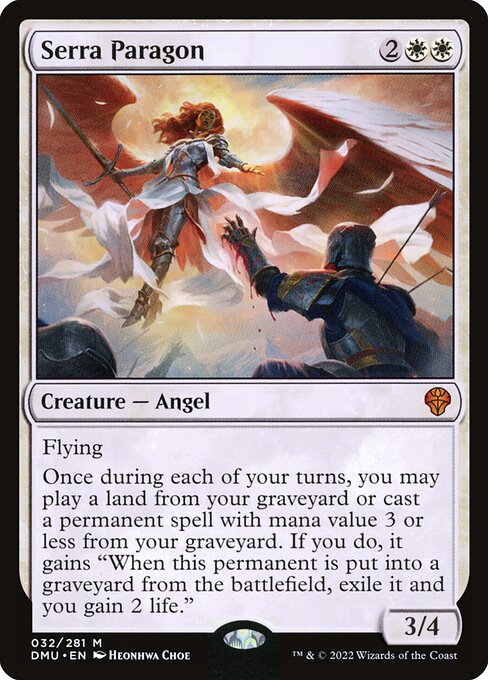
Serra Paragon: midway between Lurrus of the Dream-Den and Luminous Broodmoth is not a bad place to be. While she won’t be drawing a card every turn with Mishra’s Bauble, getting a second use out of your fetchlands, rebuying your Brutal Cathar, or recasting a Liliana late game is extremely powerful, even if you only get to do it once. Notably, this isn’t Unearth—if the permanent returned with the Paragon dies, you lose it, but if you bounce or blink it, you can still use it.
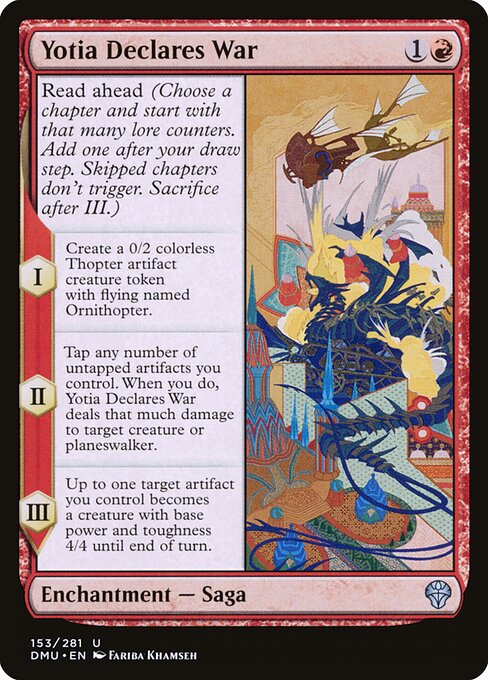
I completely ignored Yotia Declares War when it was revealed, and skipped over it when it came my way in a draft, to my chagrin. Making a single Ornithopter is pretty unimpressive, but turning your spare artifacts into removal and then a one-shot Ensoul Artifact—or any of this mix as needed, thanks to Read Ahead—is quite a lot of value for two mana.
In Standard right now, we have Oni-Cult Anvil, Experimental Synthesizer, Blade of the Oni, Lizard Blades, Lion Sash, Reckoner Bankbuster, Unlicensed Hearse, Eater of Virtue, Goldhound, Iron Apprentice, Luxior, Giada’s Gift, Rabbit Battery, Simian Sling, Weatherlight Compleated, and Reinforced Ronin as relevant artifacts at two mana or fewer. This gives Oni-Cult decks more reach and more cheap artifacts, which may just be the critical mass the deck needs to pick up momentum.
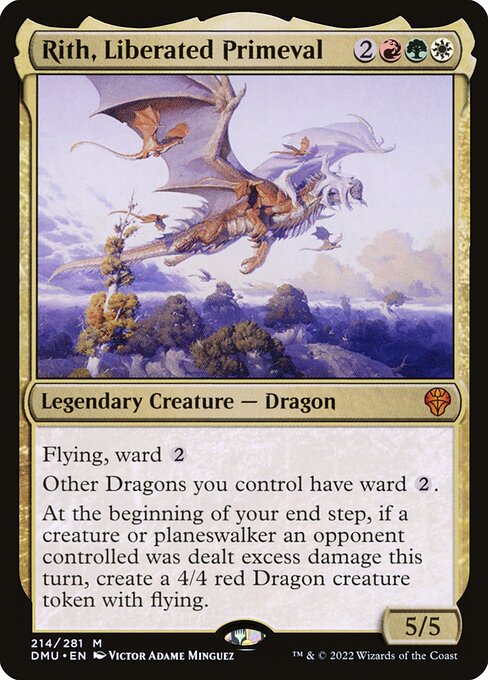
Soul of Windgrace, Shanna, Purifying Blade, and Rith, Liberated Primeval: I think we’ve gotten a bit spoiled lately with the power level of creatures. Soul of Windgrace is a five-power creature for four mana that buys back your Riveteers Overlook and lets you cash in unneeded lands for useful effects. Rith wins games by its own, while creating a Dragon army after a few turns.
Shanna, meanwhile, is the Broker that was promised—a cheap brawler that turns ancillary life gain into card draw and holds counters, both +1/+1 and Shield, exceptionally well. Compared to the actual Capenna family Legendary creatures, these are the cards that draw you into the color combination. Well, for the most part—poor Sol’Kanar isn’t going to be climbing the charts with the Maestros any time soon.
While on the subject of fascinating cards, I do want to give an honorable mention to Karn’s Sylex: Pernicious Deed, this is not. It can’t even be Gaze of Granite in a pinch, but it can be split up into installments and comes with a Defiler-hosing bonus. Some control decks in the previous Standard didn’t mind tapping out turn three for a Celestus, and no one minds tapping out for The Meathook Massacre, so there’s a niche for a nuclear bomb like the Sylex.
Still, the multiple drawbacks—sorcery speed, enters tapped—don’t outweigh the useful but fringe fetchland/Phyrexian mana hosing ability. It’s a difficult card to judge outside of the context of a new format—is it more Plague Boiler than Deed? More Damping Matrix than Chalice?
A changing Standard means a shakeup of the power rankings—personally, as I often do at the start of a new Standard, I’ve defaulted to high-value aggro, with a Rakdos deck that runs all the hits—Liliana, Ob Nixilis, Tenacious Underdog, Graveyard Trespasser, Bloodtithe Harvester, Strangle, etc. With Standard reduced to Midnight Hunt, Crimson Vow, Neon Dynasty, New Capenna, and Dominaria United, something has to step into the breach, and right now, running three-power creatures that trade up for your opponents’ is the place to be, particularly when backed up by the inevitability of your Planeswalkers.
But the exciting thing is the feeling of new options; we aren’t shackled to the same cores we’ve been honing for months and months, but able to explore a familiar world with familiar strategies and unfamiliar cards. Whether we land on White creatures that attack for two and exile-based removal, or all the counters backed up with a huge threat, or a graveyard deck with Urborg Lhurgoyf as payoff (wouldn’t recommend this, as someone who’s tried); we have new territory ahead of us, fresh with the promise of fall.
A lifelong resident of the Carolinas and a graduate of the University of North Carolina, Rob has played Magic since he picked a Darkling Stalker up off the soccer field at summer camp. He works for nonprofits as an educational strategies developer and, in his off-hours, enjoys writing fiction, playing games, and exploring new beers.

